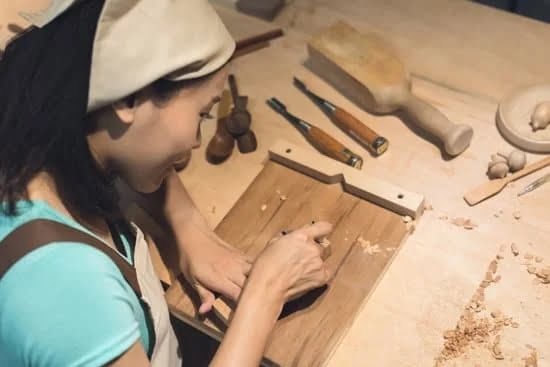The cleanliness of interior painted woodwork plays a crucial role in maintaining the overall appearance and longevity of your home. From baseboards to doors, trim to crown molding, these surfaces are often overlooked when it comes to regular cleaning.
However, neglecting the cleanliness of interior painted woodwork can result in a dingy and unkempt look, diminishing the beauty of your home’s interior. In this article, we will explore the importance of clean interior painted woodwork and the benefits of regularly maintaining its cleanliness.
Regularly cleaning your interior painted woodwork offers numerous benefits beyond just aesthetics. First and foremost, it helps to preserve the integrity of the paint and wood surfaces. Accumulated dust, dirt, and grime can gradually degrade the quality of the paint, causing it to chip or peel over time.
Additionally, neglecting to clean your painted woodwork can result in stubborn stains and blemishes that become increasingly difficult to remove. By incorporating proper cleaning techniques into your routine, you can extend the lifespan of your interior paint job and keep your woodwork looking fresh and vibrant.
Moreover, clean interior painted woodwork contributes significantly to the overall appeal of your living space. Whether you’re entertaining guests or simply enjoying some downtime at home, having well-maintained painted woodwork can make a significant difference in how aesthetically pleasing your surroundings feel. Clean baseboards and trim add a finishing touch to any room while spotless crown molding elevates the elegance and grandeur of your home’s design.
Understanding the Types of Interior Painted Woodwork
When it comes to cleaning interior painted woodwork, it’s important to have a clear understanding of the different types of surfaces you’ll encounter. Whether it’s baseboards, trim, crown molding, or doors, each type requires specific attention and cleaning techniques.
Differentiating between various types of interior painted woodwork
To effectively clean interior painted woodwork, it is vital to differentiate between the various types of surfaces found in your home. Baseboards are the pieces of wood that run along the bottom of walls, while trim refers to decorative elements around doors and windows. Crown molding adds an elegant touch where walls meet ceilings.
Doors can be made from different materials and may have intricate designs that require special care during cleaning. Identifying these different types will help you focus on individual areas and treat them accordingly.
How the type of paint used on these surfaces affects the cleaning process
Another important aspect to consider when cleaning interior painted woodwork is the type of paint used on these surfaces. Different paints have different properties that may affect how they should be cleaned. For example, oil-based paints are generally more durable but are also more difficult to clean.
Latex or water-based paints are easier to maintain but may require more frequent touch-ups due to wear and tear. Understanding these differences will help you select appropriate cleaning methods and products.
By gaining a thorough knowledge of the types of interior painted woodwork in your home and how they should be treated during cleaning, you can ensure that each surface receives proper care while avoiding any potential damage or mishaps during the process.
Gathering the Necessary Cleaning Supplies
Creating a Comprehensive Cleaning Supplies List
Before starting the process of cleaning your interior painted woodwork, it is important to gather all the necessary cleaning supplies. Having everything you need on hand will make the process more efficient and ensure that you are properly equipped to tackle any kind of dirt or grime that may be present on your woodwork.
To create a comprehensive cleaning supplies list, consider the following items:
- Soft microfiber cloths: These are essential for gentle yet effective cleaning of painted wood surfaces. They are non-abrasive and won’t scratch or damage the paint.
- Mild detergent or soap: Use a mild detergent or soap mixed with warm water for general cleaning purposes. Avoid using harsh chemicals as they can strip away the paint or damage the wood.
- White vinegar: A natural and effective cleaner, white vinegar can be used to remove stubborn stains and disinfect wood surfaces.
- Bucket: A bucket filled with warm water will come in handy for diluting cleaning solutions and rinsing your cloth.
- Soft-bristle brush: For areas with accumulated dust or dirt that can’t be easily removed with a cloth, a soft-bristle brush can be used to gently scrub away grime.
- Vacuum cleaner with soft brush attachment: Before starting the cleaning process, use a vacuum cleaner with a soft brush attachment to remove loose dust and debris from your painted woodwork.
- Protective gloves: It’s always a good idea to protect your hands when working with cleaning solutions by wearing protective gloves.
Choosing Cleaning Products That Won’t Damage
When selecting cleaning products for your interior painted woodwork, it is important to choose ones that won’t damage the paint or wood surface. Harsh chemicals, abrasive cleaners, or rough materials should be avoided as they can cause discoloration, peeling, or scratches on your beautiful woodwork.
Look for cleaning products that are specifically formulated for delicate surfaces, such as wood or painted surfaces. They should be mild and gentle, yet effective in removing dirt and grime.
If you prefer using natural cleaning solutions, white vinegar mixed with water is a great option. It is safe to use on most painted wood surfaces and helps remove stains without causing any damage.
Always test the cleaning product on a small, inconspicuous area of your painted woodwork before applying it to the entire surface. This will ensure that the product does not cause any adverse effects or discoloration.
Preparing the Woodwork for Cleaning
Before starting the process of cleaning your interior painted woodwork, it is essential to properly prepare the surfaces to ensure effective and efficient cleaning. Follow these step-by-step instructions to prepare your woodwork:
- Remove any obstacles: Begin by removing any furniture, decorations, or items that may obstruct access to the woodwork. Clearing the area around the woodwork will make it easier to reach all areas and prevent accidental damage.
- Dust off loose debris: Use a soft-bristled brush or a microfiber cloth to gently remove any loose dust or debris from the woodwork. Start from the top and work your way down, ensuring that you cover every surface thoroughly. Pay extra attention to corners, crevices, and intricate details.
- Vacuum or sweep the floor: As you clean the woodwork, there may be instances where dust or dirt falls onto the floor. To keep your cleaning process efficient, it is recommended to vacuum or sweep the floor afterward to remove any debris that has fallen.
- Protect adjacent surfaces: If you are using any cleaning products that may accidentally come into contact with other surfaces (such as flooring), take precautions by covering them with plastic sheets or drop cloths. This will prevent potential damage caused by spills or splatters.
By following these steps, you can ensure that your woodwork is properly prepared for cleaning, allowing for a more thorough and effective cleaning process.
| Step | Description |
|---|---|
| 1 | Remove any obstacles |
| 2 | Dust off loose debris |
| 3 | Vacuum or sweep the floor |
| 4 | Protect adjacent surfaces |
General Cleaning Techniques for Interior Painted Woodwork
Cleaning your interior painted woodwork is an essential part of maintaining the overall appearance and longevity of your home. Regularly cleaning your interior painted woodwork has many benefits, including preventing a buildup of dust, dirt, and grime that can dull the paint finish and damage the wood surfaces over time. In this section, we will explore some general cleaning techniques to keep your interior painted woodwork looking its best.
One effective method for cleaning interior painted woodwork is dusting. This should be done regularly to remove any loose dust or debris that has accumulated on the surfaces.
Start by using a soft microfiber cloth or duster to gently wipe down the woodwork, making sure to reach all areas such as baseboards, trim, crown molding, and doors. It may also be helpful to use a vacuum cleaner with a brush attachment to remove any stubborn dust from crevices and hard-to-reach areas.
Wiping down is another important cleaning technique for your interior painted woodwork. Fill a bucket with warm water and add a mild household cleaner that is safe for painted surfaces. Dip a soft sponge or cloth into the soapy water, wring out any excess liquid, and gently wipe down the painted woodwork. Be careful not to saturate the surfaces or let water drip onto the floor as it can cause damage.
Spot cleaning is necessary for tackling specific stains or marks on your interior painted woodwork. Use a gentle cleaner specifically designed for removing tough stains without damaging paint or wood surfaces. Apply a small amount of the cleaner onto a clean cloth or sponge and dab it onto the stain. Gently rub in circular motions until the stain lifts away.
Regularly employing these general cleaning techniques will help keep your interior painted woodwork looking clean and fresh. Incorporating these practices into your regular cleaning routine will ensure that you maintain the beauty and durability of your home’s interior while prolonging the lifespan of your paints and woods.
Dealing with Stubborn Stains and Blemishes
When it comes to interior painted woodwork, stubborn stains and blemishes can be a real headache. Whether it’s a mark from a piece of furniture being dragged across the woodwork or a stubborn stain that just won’t come out, these imperfections can detract from the overall appearance of your home. However, with the right techniques and products, you can effectively remove these stubborn stains and blemishes and restore the beauty of your interior painted woodwork.
One of the first steps in dealing with stubborn stains and blemishes is to identify the type of stain you’re dealing with. Different types of stains require different treatment methods. For example, water-based stains are typically easier to remove than oil-based stains. Once you’ve identified the type of stain, you can choose the appropriate cleaning product or technique.
Here are some specialized techniques and products for different types of stains:
- Grease Stains: Grease stains can be common on kitchen cabinets or baseboards near cooking areas. To remove grease stains, mix a small amount of dish soap with warm water and use a soft cloth to gently scrub at the stain. Rinse with clean water and pat dry.
- Ink Stains: Ink stains can be particularly challenging to remove from painted woodwork. One effective method is using rubbing alcohol or nail polish remover (acetone) applied lightly on a cloth. Blot at the stain until it lifts away. Be careful not to rub too hard as this may damage the paint.
- Water Stains: Water stains are often caused by spills or condensation. To remove water stains, apply a mixture of equal parts vinegar and water onto a cloth or sponge. Gently rub at the stain until it fades away. Rinse with clean water afterward.
- Scuff Marks: Scuff marks are often caused by shoes or furniture being dragged across the woodwork. To remove scuff marks, try using a pencil eraser or a slightly damp magic eraser sponge. Gently rub at the mark until it disappears.
Remember, it’s important to always test any cleaning product or technique on a small, inconspicuous area of the woodwork first to ensure it doesn’t damage or discolor the paint. By using these specialized techniques and products for different types of stains, you can effectively remove stubborn stains and blemishes from your interior painted woodwork and restore its beauty.
Protecting and Maintaining the Cleanliness of Interior Painted Woodwork
Maintaining the cleanliness of interior painted woodwork is crucial for preserving its beauty and prolonging its lifespan. Once you have put in the effort to clean your woodwork, it is important to protect it from future damage and keep it looking pristine. In this section, we will discuss some tips and tricks for protecting and maintaining the cleanliness of your interior painted woodwork.
To start with, consider using protective products such as clear sealants or topcoats specifically designed for painted wood surfaces. These products create a barrier that helps prevent stains, scratches, and other forms of damage. Before applying any protective product, make sure to thoroughly clean the woodwork and follow the manufacturer’s instructions for application.
In addition to using protective products, there are also certain practices you can adopt to maintain the cleanliness of your interior painted woodwork. One important tip is to avoid placing objects directly against the woodwork, as this can lead to scratches or smudges. Use coasters under glasses and felt pads under decorative items or furniture to prevent them from causing damage.
Regular maintenance is also key in preserving the cleanliness of your interior painted woodwork. Make it a habit to dust the surfaces regularly using a soft cloth or microfiber duster. This will help prevent dust from settling and accumulating on the surfaces. Additionally, wipe down your woodwork with a slightly damp cloth every few weeks or as needed to remove dirt or smudges.
Proper care and maintenance of your interior painted woodwork not only contribute to its longevity but also ensure that it continues to enhance the overall appearance of your home. By following these tips for protection and maintenance, you can enjoy beautiful and clean interior painted woodwork for years to come.
Final Touches and Extra Tips
After completing the cleaning process for your interior painted woodwork, it’s time to add those final touches that will make your woodwork shine. Here are some tips to achieve a flawless finish:
- Polish the Woodwork: Use a high-quality wood polish or wax to bring out the natural luster of the wood. Apply a small amount of polish onto a soft cloth and gently rub it onto the surface in circular motions. This will not only make your woodwork look shiny but also help protect it from everyday wear and tear.
- Consider Touch-Up Painting: If you notice any scratches, chips, or areas where the paint has worn off, consider doing touch-up painting to restore the appearance of your interior painted woodwork. Use a small brush or a paint pen in a color that matches your existing paint, and carefully fill in the damaged areas.
- Pay Attention to Details: Don’t forget about those little details that can make a big difference in the overall cleanliness and appearance of your interior painted woodwork. Take a close look at corners, edges, and hard-to-reach areas to ensure they are free from dust or dirt. Use a cotton swab or toothbrush dipped in mild soapy water to gently clean these areas.
Here are some extra tips to keep in mind while cleaning your interior painted woodwork:
- Avoid using abrasive cleaners or harsh chemicals that can damage the paint or wood surfaces.
- Always test any cleaning product on an inconspicuous area first before applying it to the entire surface.
- Regularly dust and wipe down your interior painted woodwork to prevent dirt build-up.
- Avoid excessive moisture when cleaning as it can cause peeling or warping of the paint.
- Schedule regular maintenance cleanings every few months to keep your interior painted woodwork looking its best.
By following these final touches and extra tips, you can ensure that your interior painted woodwork remains clean, beautiful, and well-maintained for years to come. Now sit back, relax, and enjoy the beauty of your freshly cleaned woodwork throughout your home.
Conclusion
In conclusion, maintaining clean interior painted woodwork is essential for the overall appearance and longevity of your home. By regularly cleaning your woodwork, you can enjoy the benefits of a fresh and vibrant living space. The different types of interior painted woodwork, such as baseboards, trim, crown molding, and doors, require specific cleaning techniques based on the type of paint used.
To properly clean your interior painted woodwork, gather the necessary cleaning supplies that won’t damage the paint or wood surfaces. Prepare the woodwork by removing any obstacles and ensuring easy access to all areas. There are various general cleaning techniques you can use, such as dusting, wiping down, and spot cleaning to remove accumulated dust, dirt, and grime from the surfaces.
If you come across stubborn stains or blemishes, there are specialized techniques and products available to effectively remove them without causing damage. Once your interior painted woodwork is clean, it is important to protect and maintain its cleanliness in the long run. Use protective products and practices to prevent future damage or staining.
Frequently Asked Questions
How do you clean wood without damaging paint?
Cleaning wood without damaging the paint requires careful consideration of the cleaning method and products used. Start by dusting the surface using a soft cloth or brush to remove any loose debris. For light cleaning, a gentle solution of mild dish soap mixed with warm water can be applied to a clean cloth or sponge. Wring out excess liquid and lightly wipe the wood surface, ensuring not to scrub vigorously as this may damage the paint.
Rinse the cloth or sponge frequently to avoid spreading dirt on the wood. After cleaning, dry the wood thoroughly with a clean towel to prevent moisture damage. Avoid using abrasive cleaners, harsh chemicals, or rough scouring pads as these can strip away paint and cause lasting damage.
How do you clean painted woodwork and trim?
To effectively clean painted woodwork and trim, it is important to follow a gentle cleaning routine that removes dirt and grime without causing any harm. Begin by wiping down the surfaces with a soft microfiber cloth or duster to eliminate loose particles. Then, prepare a solution of warm water and mild dish soap in a bucket or bowl.
Dip a non-abrasive sponge into the soapy water, wring out excess liquid, and gently wipe down the painted woodwork in small sections at a time, being cautious not to oversaturate the surface with water. Rinse the sponge regularly and change out dirty water as needed to maintain cleanliness throughout. Once all areas have been cleaned, use a fresh damp cloth to remove any remaining soap residue from the woodwork before allowing it to air dry completely.
What is the best way to clean dirty woodwork?
The best approach for cleaning dirty woodwork involves removing accumulated grime while preserving its finish and integrity. Firstly, start by dusting off loose debris using a soft brush or microfiber cloth in order to prevent scratching during subsequent steps. Next, create a mixture of warm water and mild detergent such as dish soap in a bucket or basin. Wet a clean cloth with this soapy solution – ensuring not to soak it excessively – and gently wipe the dirty woodwork, paying attention to the nooks and crannies. Rinse the cloth frequently in clean water to prevent reintroducing dirt onto the surface.
If there are stubborn stains or buildup, a slightly more abrasive cleaner like a diluted vinegar solution can be considered for use. However, it is important to test this mixture on an inconspicuous area first to ensure that it does not cause any damage. After cleaning, dry the woodwork thoroughly using a separate cloth or towel, making sure no moisture remains to avoid potential warping or rotting of the wood. Regular upkeep with gentle cleaning methods will help maintain the beauty of your woodwork and extend its lifespan.

Hi everyone! I’m a woodworker and blogger, and this is my woodworking blog. In my blog, I share tips and tricks for woodworkers of all skill levels, as well as project ideas that you can try yourself.





